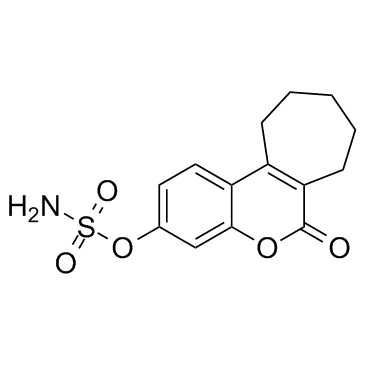STX64

STX64 structure
|
Common Name | STX64 | ||
|---|---|---|---|---|
| CAS Number | 288628-05-7 | Molecular Weight | 309.33800 | |
| Density | N/A | Boiling Point | N/A | |
| Molecular Formula | C14H15NO5S | Melting Point | N/A | |
| MSDS | Chinese USA | Flash Point | N/A | |
Use of STX64Irosustat is a potent steroid sulfatase inhibitor, with an IC50 of 8 nM, and exhibits anti-breast cancer activity. |
| Name | (6-oxo-8,9,10,11-tetrahydro-7H-cyclohepta[c]chromen-3-yl) sulfamate |
|---|---|
| Synonym | More Synonyms |
| Description | Irosustat is a potent steroid sulfatase inhibitor, with an IC50 of 8 nM, and exhibits anti-breast cancer activity. |
|---|---|
| Related Catalog | |
| Target |
IC50: 8 nM (Steroid sulfatase)[1], 0.2 nM (Steroid sulfatase, MCF-7 cells)[2] |
| In Vitro | Irosustat (667 COUMATE) is a potent steroid sulfatase inhibitor, with an IC50 of 8 nM[1]. Irosustat (667 COUMATE) inhibits steroid sulphatase (STS) activity in MCF-7 cells with an IC50 of 0.2 nM, but has no effect on the morphology or proliferation of MCF-7 cells at 10 μM[2]. |
| In Vivo | Irosustat potently inhibits rat liver, with inhibition of >90% when at a 1 mg/kg concentration. Irosustat (2 mg/kg, p.o. for 5 d) blocks the uterine growth stimulated by oestrone sulfate (E1S) in ovariectomized rats. In addition, Irosustat (2, 10 mg/kg, p.o.) plus E1S dose-dependently decreases the growth of NMU-induced mammary tumors in ovariectomized rats[1]. Irosustat (667 COUMATE; 10 mg/kg, p.o.) shows 97.9 ± 0.06% inhibition on steroid sulphatase (STS) activity in rat liver[2]. |
| Cell Assay | MCF-7 cells are cultured in growth medium (minimum essential medium (MEM) containing, phenol red, 10% foetal calf serum (FCS) and essential nutrients). When the cells reach 60% confluency, they are treated with Irosustat (0.001-10 μM) in growth medium. After 72 h of incubation, photographs are taken under normal conditions of light and the number of attached cells in each flask is determined using a Coulter cell counter[2]. |
| Animal Admin | Rats[1] Ludwig rats bearing mammary tumors are used in the assay. Tumor development is monitored, and animals are ovariectomized when tumors reach 0.8-1.5 cm in diameter. Tumors are allowed to regress over a 12- to 13-day period to confirm their hormone-dependent status. Regrowth of tumors is stimulated with oestrone sulfate (E1S; 50 μg/day, s.c.). When tumors have regrown, animals continue to receive either E1S alone or E1S plus Irosustat at 10 mg/kg/day or 2 mg/kg/day, p.o., until tumor regression has occurred. Tumor volumes are calculated from two measured diameters[1]. |
| References |
| Molecular Formula | C14H15NO5S |
|---|---|
| Molecular Weight | 309.33800 |
| Exact Mass | 309.06700 |
| PSA | 107.98000 |
| LogP | 3.42530 |
| InChIKey | DSLPMJSGSBLWRE-UHFFFAOYSA-N |
| SMILES | NS(=O)(=O)Oc1ccc2c3c(c(=O)oc2c1)CCCCC3 |
| Storage condition | 2-8℃ |
| Personal Protective Equipment | Eyeshields;Gloves;type N95 (US);type P1 (EN143) respirator filter |
|---|---|
| RIDADR | NONH for all modes of transport |
|
Evidence of estrone-sulfate uptake modification in young and middle-aged rat prostate.
J. Steroid Biochem. Mol. Biol. 152 , 89-100, (2015) High plasma exposure to estrogens is often associated with prostate cancer. Reducing this phenomenon may present therapeutic benefits. The involvement of estrone sulphate (E1S), the most abundant circ... |
|
|
Anti-tumor effect of Shu-Gan-Liang-Xue decoction in breast cancer is related to the inhibition of aromatase and steroid sulfatase expression.
J. Ethnopharmacol. 154(3) , 687-95, (2014) Shu-Gan-Liang-Xue Decoction (SGLXD), a traditional Chinese herbal formula used to ameliorate the hot flushes in breast cancer patients, was reported to have anti-tumor effect on breast cancer. Estroge... |
|
|
Inflammatory regulation of steroid sulfatase: A novel mechanism to control estrogen homeostasis and inflammation in chronic liver disease.
J. Hepatol. 64 , 44-52, (2015) Chronic inflammatory liver diseases are associated with estrogen excess and feminization in men, which is thought to be due to compromised liver function to break down estrogens. The goal of this stud... |
| 667 Coumate BN 83495 |
| Irosustat |
| STX64 |
| 1ttm |
| 667-Coumate |